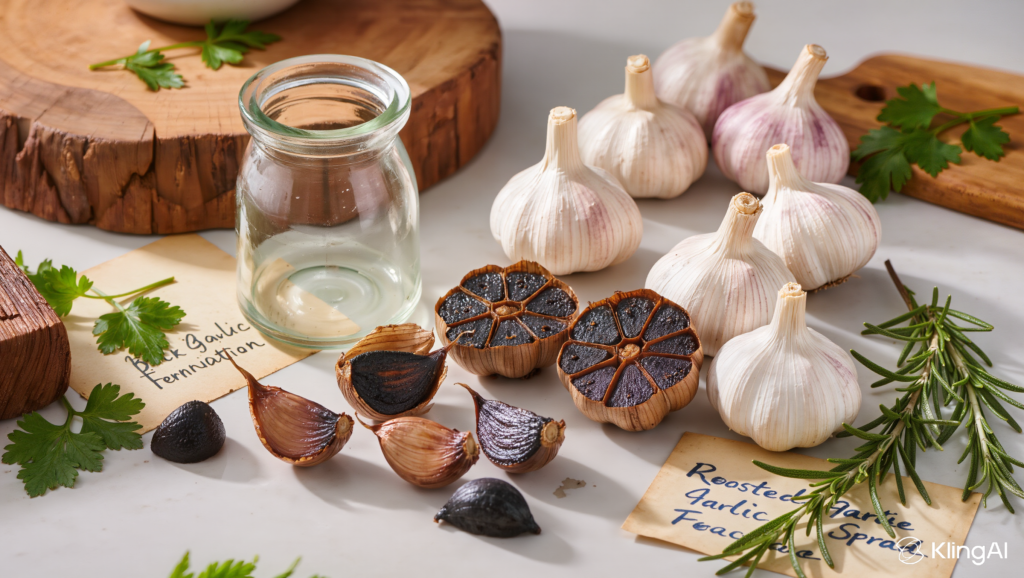If you’re into wellness trends or culinary adventures, you’ve probably heard whispers about black garlic—a sweet-and-savory ingredient that’s turning chefs’ heads and popping up in health blogs everywhere. This fermented form of regular garlic is not just a flavor bomb but earns its “superfood” status with an impressive nutritional profile and plenty of legit science to back up the hype. Whether you want to boost your immune system, support your heart, or just want a natural treat that tastes a little like balsamic candy, black garlic is worth a closer look. Let’s dive deep into the origins, science, recipes, and DIY methods so you can put this delicious powerhouse on your menu—and even on your kitchen counter.
What Is Black Garlic, Anyway?
Black garlic is simply whole fresh garlic bulbs that have been “aged” (read: held at a warm temperature and high humidity) for several weeks. This controlled cooking triggers what’s called the Maillard reaction—the same process that toasts bread or roasts coffee—and transforms the cloves from white and pungent to jet black, sticky, and sweet.
- Taste: Imagine caramel, dark molasses, umami, subtle balsamic, with zero of the sharpness that raw garlic lovers (or haters) know all too well.
- Texture: Soft, spreadable, chewy—think dried fruit meets roasted garlic.
- Fun fact: Contrary to popular belief, black garlic is not actually “fermented” by bacteria, but undergoes a low-and-slow Maillard browning process.
How Black Garlic Differs from Regular Garlic
- Nutrients: While raw garlic is known for allicin (the compound with pungent aroma and many benefits), black garlic has higher levels of antioxidants and contains unique compounds like S-allyl cysteine (SAC), which is more stable and easier for the body to absorb.
- Digestibility: Reduced allicin means black garlic is milder on the stomach—a great choice if raw garlic irritates you.
- Flavor & Culinary Use: No harsh, spicy bite; black garlic brings a notably complex, sweet umami flavor to dishes, which explains its popularity among chefs.
The Science-Backed Health Benefits of Black Garlic
1. Potent Antioxidant Power
- 10x more antioxidants than raw garlic! When garlic “ages,” unstable allicin transforms into potent antioxidant molecules—shielding cells from oxidative stress and potentially lowering inflammation that leads to aging and disease.
- Active compounds like S-allyl cysteine boost the body’s own antioxidant defenses via pathways involving Nrf2 and key cellular enzymes.
2. Heart Health Hero
- Regular consumption is linked to improved cholesterol profiles, lower triglycerides, and, crucially, reduced levels of homocysteine—a molecule tied to cardiovascular disease risk.
- By helping relax blood vessels and protect arteries, black garlic may help keep your heart in solid shape according to several clinical reviews.
3. Immune System Boost
- Garlic has long been prized for boosting immunity, but black garlic’s enhanced antioxidants and unique sulfur compounds up its infection-fighting game, potentially protecting against common viral and bacterial bugs.
4. Blood Sugar and Diabetes Management
- Studies suggest black garlic can regulate blood sugar, lower fasting glucose, and even decrease the risk of gestational diabetes—with some early evidence it may help prevent the kind of cellular damage that leads to diabetic complications.
5. Brain Health & Neuroprotection
- Frequent consumption of black garlic (thanks to those antioxidants and anti-inflammatories) may help protect against neurodegenerative conditions like Alzheimer’s and dementia by reducing cell damage in the brain.
6. Cancer-Fighting Compounds
- While more research in humans is still needed, lab studies have shown that black garlic extracts can slow the growth of several cancer cell lines, including colon and breast cancers.
7. Bonus: Weight, Libido & More
- There’s preliminary evidence that black garlic might support weight management, increase libido (especially in men, in traditional medicine), and help protect liver function.
Nutrition Profile: What’s in a Clove?
- Calories: ~143 kcal /100g (very low)
- Fat: 2g per 28g serving (almost no saturated fat)
- Carbs: 4g per 28g (mostly fiber—great for metabolism)
- Protein: 1g per serving
- Packed with small but significant amounts of calcium, iron, vitamin C, and more.
- No cholesterol, negligible sugar.
Black garlic is a guilt-free addition to almost any diet—vegan, heart-healthy, low-calorie, or gluten-free.
How to Use Black Garlic in Your Kitchen
Besides eating it straight (seriously, it tastes like tangy-sweet candy!), black garlic shines in all sorts of recipes:
- Pasta and Risottos: Add chopped cloves for richness
- Pizzas and Grains: Sprinkle over before baking or serving
- Sauces and Dressings: Blend a clove or two into vinaigrettes or dips
- Beans, Stews, or Soups: Adds deep, rounded flavor
- Hummus, Dips, or Pestos: For a fun twist on classics
- With Roasted Veggies or Meats: Mash and spread for an intensely savory glaze.
How To Make Black Garlic at Home
You don’t need fancy tools—just patience!
What You Need:
- Whole heads of fresh garlic—leave them unpeeled
- A rice cooker, slow cooker with a “keep warm” setting, or a bread proofer
Instructions:
- Clean the garlic heads (remove dirt but keep skins on).
- Wrap each head in a double layer of foil (to retain moisture).
- Arrange garlic in your appliance (don’t stack heads too tightly).
- Set appliance on “keep warm” (~60–77°C/140–170°F). Avoid higher temps—too much heat cooks garlic, but doesn’t create black garlic’s signature flavor.
- Leave for 3–4 weeks. Check occasionally for dryness or burning, but don’t open unless you must (opening increases moisture loss).
- Unwrap and cool. The cloves will be black, sweet, and sticky!
Key Notes:
- Do not use a regular oven—it usually can’t hold temps low or stable enough over weeks.
- Odor: The process can make your kitchen (or whole house) smell…strong. Some pros recommend keeping your appliance outdoors or in a ventilated space.
- Store in the fridge in airtight containers. Will last 1–2 months.
Pro Tips & Troubleshooting
- Cut open a clove—if it’s not jet black and soft, give it more time.
- Too dry? Wrap a soaked paper towel around the foil layer (but not touching the garlic).
- Mold? Discard and try again, ensuring equipment is clean and moisture is correct.
Final Thoughts: Is Black Garlic Worth the Hype?
Yes! With amazing taste, powerful health benefits, and straightforward DIY potential, black garlic lives up to its superfood billing. Its unique compounds and heightened antioxidants make it more than just a kitchen curiosity—it’s a simple, science-backed boost for your heart, brain, immune system, and more.
If you haven’t tried it yet, you’re missing out. Make your own or grab some from a specialty shop, and see why so many are swapping out their candy for a clove of this tangy-sweet powerhouse.
Did you find this article helpful? Support us by following us on our social media pages—Youtube, Instagram, Facebook, Pinterest, Twitter (X))—and stay up to date on other exciting topics related to natural health and wellness.








